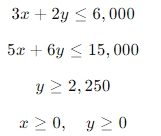- 10 Marks
QTB – May 2017 – L1 – SB – Q6a – Statistics
Calculate the monthly cost of replacing diodes based on failure probability and determine if a student can buy a gown based on expected money.
Question
i. The laptops that are purchased by a company have 742 diodes with a life span of five months. These diodes fail on a regular basis according to the following probability distribution:
| Life (months) | 1 | 2 | 3 | 4 | 5 |
|---|---|---|---|---|---|
| Probability of failure | 0.10 | 0.30 | 0.35 | 0.20 | 0.05 |
If the cost of replacing a diode is ₦100, calculate the monthly cost of replacing the diodes as they fail. (4 Marks)
ii. Tadet, a student in the Accountancy Department of a Polytechnic, has the following chances of receiving money from her relatives:
- 45% chance of receiving ₦5,000 from her sister,
- 33% chance of receiving ₦8,000 from her brother,
- 16% chance of receiving ₦11,000 from her aunt,
- 6% chance of receiving ₦15,000 from her uncle.
Determine if Tadet will be able to buy a gown worth ₦8,000 from the money she is expecting from her relatives. (6 Marks)
Find Related Questions by Tags, levels, etc.
- Tags: Cost Calculation, Expected Value, Financial planning, Probability Distribution
- Level: Level 1
- Topic: Statistics
- Series: MAY 2017
You're reporting an error for "QTB – May 2017 – L1 – SB – Q6a – Statistics"
- 10 Marks
QTB – May 2017 – L1 – SB – Q6a – Statistics
Calculate the monthly cost of replacing diodes based on failure probability and determine if a student can buy a gown based on expected money.
Question
i. The laptops that are purchased by a company have 742 diodes with a life span of five months. These diodes fail on a regular basis according to the following probability distribution:
| Life (months) | 1 | 2 | 3 | 4 | 5 |
|---|---|---|---|---|---|
| Probability of failure | 0.10 | 0.30 | 0.35 | 0.20 | 0.05 |
If the cost of replacing a diode is ₦100, calculate the monthly cost of replacing the diodes as they fail. (4 Marks)
ii. Tadet, a student in the Accountancy Department of a Polytechnic, has the following chances of receiving money from her relatives:
- 45% chance of receiving ₦5,000 from her sister,
- 33% chance of receiving ₦8,000 from her brother,
- 16% chance of receiving ₦11,000 from her aunt,
- 6% chance of receiving ₦15,000 from her uncle.
Determine if Tadet will be able to buy a gown worth ₦8,000 from the money she is expecting from her relatives. (6 Marks)
Find Related Questions by Tags, levels, etc.
- Tags: Cost Calculation, Expected Value, Financial planning, Probability Distribution
- Level: Level 1
- Topic: Statistics
- Series: MAY 2017




